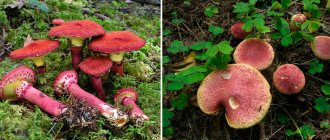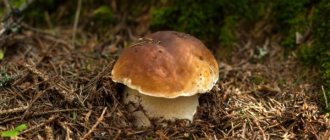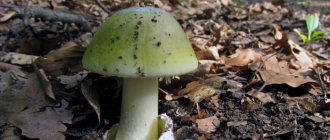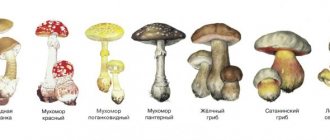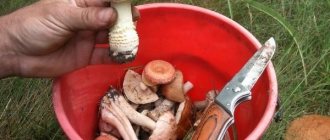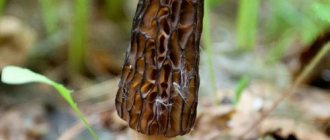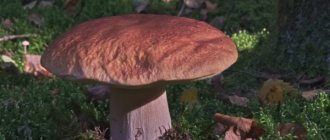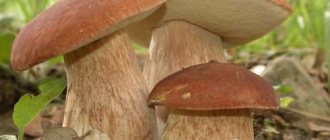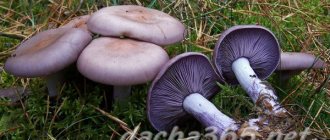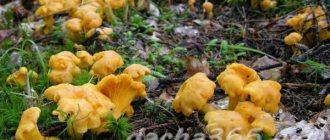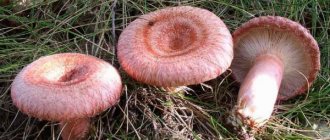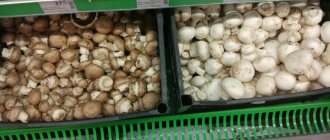In 2022, mushrooms are also available in the Tver region, and in large quantities. Mushroom pickers who visited the forest at least once managed to collect a treasure trove of fruits, which were used for pickles, preparing first and second courses, appetizers and pates. From early spring until the end of autumn, Tver pampers local residents with its rich and incredibly tasty harvest of mushroom fruits. And if our readers have not yet managed to collect their share, it’s time to go on a quiet hunt, picking up edible and conditional mushrooms that are suitable for cooking any dishes.
The principle of life is you for me, I for you
We, ordinary people and lovers of “quiet hunting,” are mostly familiar with the so-called basidiomycetes, which form fruiting bodies - stems and caps. But there are a huge number of molds, also well known to many of us from dampness on the walls and spoiled food, but in the wild there are thousands of species. There are many microscopic fungi that live in water, because there are many nutritious organic elements dissolved there. And there are purely parasitic fungi that can only exist at the expense of the host, including in the human body.
In general, the overwhelming majority of fungi form mycelium (mycelium) precisely in close interaction with the roots of other plants. Here the cooperation is mutually beneficial - some plants cannot do without mycelium at all and live according to the principle - “you give me, I give you.”
— In the botanical garden we are trying to find the optimal soil for growing rhododendrons. It turns out that they do not germinate from seeds at all in sterile soil, but only in soil infected with a fungus. The mycelium helps plants absorb minerals, that is, first the mushrooms take them, process them, and then they are absorbed by the roots of rhododendrons.
What is collected in spring, summer and autumn
| Types of mushrooms | Growth period |
| Morels | May |
| Field champignons | May-October |
| Boletus | June-September |
| Russula | June-September |
| boletus | June-October |
| Oyster mushrooms | End of June-October |
| Boletus | End of June – end of October |
| Loadings | July-September |
| Butter | July-September |
| Chanterelles | July-October |
| Polypores | July-October |
| Milk mushrooms | Aug. Sept |
The mushroom riches of the region will not leave indifferent both an experienced mushroom picker and an enthusiastic lover of “silent hunting”. Knowledge of good places and the ability to distinguish between beneficial and harmful species will allow you to collect full baskets of delicious gifts of nature.
Sexual reproduction
Why do mushrooms need stems and caps? Wise nature came up with this for a reason: for reproduction. The cap contains spores; when they ripen, the mushroom needs to raise the cap as high as possible to help the sowing wind. By the way, this method of reproduction in fungi is called sexual. Unlike most organisms, which are divided into male and female, fungi have about 18 sexes, which combine in different ways. For example, the 3rd can only with the 5th and 7th, etc. So the process of reproduction in mushrooms is very exciting!
The area of the mycelium can reach several square meters; this requires two conditions - the presence of a nutrient medium and moisture. Fungi settle in the soil, in wood, in litter (fallen leaves or needles), etc.
The first and last mushrooms
As for heat, not all mushrooms need it. There are autumn species that wait for cold weather - sharp changes in day and night temperatures. For example, very tasty honey mushrooms. Of course, we are not talking about significant negative indicators. But as soon as cold nights arrive, this is a signal for the mycelium - it’s time to form fruiting bodies. And mushrooms can grow up to an average daily temperature of -10 degrees.
- This is not scary for mycelium, it is very rich in nutrients - sugars, acids and other microelements. This is not water, it’s a mycelium and at sub-zero temperatures it feels quite normal.
The first mushrooms appear in our forests towards the end of May - morels and strings, then come chanterelles and russula, because after the soil thaws, the mycelium needs a month to accumulate nutrients.
Mushroom places
On the territory of the Tver region there are several places that are often visited by mushroom pickers and delight with a large number of mushrooms:
- In the untouched forest near the airport on the territory of Konakovo, moss mushrooms, Polish mushrooms, honey mushrooms and white mushrooms are often found.
- At the 18th kilometer of the Bezhenskoye Highway, autumn species of mushrooms grow, boletus, boletus, and dark milk mushrooms.
- In the coastal areas of the Volga, next to the highways, you can find obabkas, rows, boletus, and saffron milk caps.
- Mednoye and Kumordino abound in boletus.
- Bluecaps, boletuses and boletuses are found in small quantities near the Yunost residential complex.
Flag of the Tver region
The top five areas for harvesting a bountiful harvest include the following:
- In the forests of Vasilyevsky Moss near the village of Zavolzhsky, many mushrooms are collected throughout the spring-autumn season.
- The pine forest near the village of Semenovskoye is rich in boletus mushrooms, trumpet mushrooms and milk mushrooms.
- In the forest near the village of Poddubye there are chanterelles, white chanterelles, obabkas, and boletus.
- In the forest belt near the highway to Staritsa all the way from Kalinovo to Rzhev you can find saffron milk caps, boletuses, and large chanterelles.
- The forest areas along the Turginovskaya road, where russula and chanterelles grow, are also famous.
Edible - inedible
About 300 species of edible and conditionally edible mushrooms grow in the Tver region (the latter simply require special processing). But there are few species that are categorically poisonous - the pale grebe and several varieties of fly agarics.
— Surprisingly, no one here collects tinder fungi that grow on trees. The tinder fungi need to be soaked and boiled. In the Tver region, the sulfur-yellow tinder fungus is very common. This is a very tasty mushroom. They must be collected before the moment when it begins to grow stiff. It has no poisonous analogues (false mushrooms). If you find a bright yellow mushroom on a tree, like chaga, that’s it, the sulfur-yellow tinder fungus.
As for fly agarics, they are indeed food for moose, for example, not medicine, but simply pasture. But squirrels and hedgehogs do not eat mushrooms and only collect them in cartoons. By the way, fly agarics are a good indicator beacon. If you find a lot of fly agaric mushrooms in the forest, then most likely there will be edible mushrooms - boletus, boletus, boletus, because they all live in the same conditions. Of course, the timing of ripening of fruiting bodies may vary. You just need to remember this place and come with a basket to check it out again.
Edible mushrooms 2022, TOP 10 most popular
Although the tastes of mushroom pickers remain the same, depending on the year, the amount of germination of each species may differ. The following 10 species show good yields in the coming year:
- No. 1 - morels
Do not confuse with lines prohibited for collection! The very first mushrooms appear in aspen plantings, regardless of the forest or soil fertility. In the presence of precipitation and moderate temperatures, not reaching 20 degrees during the daytime, the fruits continue to bear fruit until mid-May. Germination time may vary, moving forward or backward, depending on the weather.
- No. 2 - oyster mushrooms
Oyster mushrooms remain a favorite of many cooks. Mushrooms are tasty and do not require heat treatment, suitable for preparing all kinds of dishes, freezing for the winter and even pickling. And although such a gift from the forest is rare and is found in most cases on fallen trees, the gift is not excluded from the list of current mushrooms.
- No. 3 - porcini mushrooms
White or boletus belongs to the family of noble species, found in the autumn months in the deciduous or mixed part of the forest. Germination lasts several months, stopping only with the arrival of frost. In the event of abnormal warming, fruiting may continue even in the winter months. Mushrooms are suitable for any cooking options, including winter recipes.
- No. 4 - butter
Snot mushrooms that germinate in conifers most often bear fruit when planted in young trees. They can be detected in mid-spring or autumn, when the air temperature at night differs significantly from daytime levels.
- No. 5 - boletus and boletus
In common parlance, obabki are representatives of noble breeds. They are not subjected to heat treatment in order to preserve the delicate taste and captivating mushroom aroma.
- No. 6 - chanterelles
Not only in Belarus, but also in Russia, chanterelles are admired by local residents. In search of them, they go to proven places in the Tver region to collect full baskets of mushrooms to prepare for the winter. The most delicate taste and bright mushroom aroma are perfectly manifested not only in the marinade, but also in the mushroom pate, rolled under the lid.
- No. 7 - russula
Conventional and edible subspecies of these mushrooms are not recommended for beginners to collect. Due to its similarity with the fly agaric, after rain, when washing off the white specks from the cap, it is easy to confuse the poisonous mushroom with the edible one, known in the world of mushroom pickers. And although this seems unrealistic, history confirms such cases of critical errors.
- No. 8 - honey mushrooms
Compared to other mushrooms, honey mushrooms germinate in the Tver region almost all year round. Even in winter, provided the air temperature is above zero, many mushroom pickers manage to collect flammulina from the trunks of deciduous trees.
- No. 9 - row
The most common mushroom, slightly inferior in fruiting to the honey mushroom, remains the row. Thanks to the variety of subspecies, mushroom pickers manage to collect full baskets of mushroom harvest not only in the summer and autumn months, but also in spring, when nature is just beginning to awaken.
- No. 10 - milk mushrooms
The noble milk mushroom, although it requires preliminary heat treatment, is famous for its unique taste and crispy texture, reminiscent of pickled lightly salted cucumbers.
Mushroom diet
Mushrooms contain a large amount of proteins and carbohydrates in the form of fiber. But the fact is that these proteins are poorly absorbed by humans. Therefore, mushrooms are a low-calorie food. In addition, they take a long time to digest and give a feeling of fullness, which is why nutritionists recommend mushrooms for those suffering from excess weight.
When we walk through the forest, mushroom spores fly into our mouths, but they are not dangerous, since our body simply digests them. Like yeast, about which there is now a lot of controversy - whether they are beneficial or harmful.
“I don’t see any problems with eating yeast at all.” And even if we use them raw, for example, we tried kneaded dough, nothing bad will happen. Yeasts do not live in us. They are also digested in our food system.
About Tver champignons and rare mushrooms
According to Alexander, now in the Tver region the species diversity of mushrooms has not decreased at all: in our forests we will find saffron milk caps, milk mushrooms, honey mushrooms, chanterelles, porcini mushrooms, champignons, and many other mushrooms. You just need to look for them in forests located far from cities and not so visited.
Black breast
— We have a lot of wild champignons growing in our region. They are very tasty and safe. They can even be eaten raw. Several types of champignons grow in the Tver forests, but the most common are common champignons, which we buy in stores. They produce good harvests every year, you just need to find places.
A very interesting and beautiful mushroom that is found quite often in the Tver region is chickweed. At first, like a nut, it crawls out of the ground, and then it opens up and becomes like a starfish.
There is another unusual and rare mushroom listed in the Red Book - Mutinus caninus. This mushroom first emerges from the ground in the form of an “egg,” and then it bursts and red-pink fruiting bodies with a mesh at the top emerge. In appearance, the mushrooms resemble the genital organ of a dog, which is why they got their name. These mushrooms are inedible, but they look impressive.
Several species of fungi form fruiting bodies around the perimeter of the mycelium, forming so-called “witch circles”. This is an interesting natural phenomenon, which is reflected in folklore. As you can see, there is nothing supernatural here. This is how dung beetles grow, which are considered edible mushrooms, but they need to be collected while they are small. And also milkweeds, talkers, rows, champignons, fly agarics, morels...
This is what dung beetles look like
Dangerous and poisonous mushrooms - should not be collected!
Unfortunately, there is no place where poisonous and false subspecies, capable of causing irreparable harm to human health, have not sprouted next to the edible gifts of the forest. One way to avoid poisoning and intoxication of internal organs is to refuse to collect fruits that contain in their pulp: poisons, toxins and carcinogens that do not decompose even after heat treatment.
Particular care should be taken with the following mushrooms:
- red fly agaric;
- death cap;
- false honey mushrooms;
- gall fungus;
- smelly fly agaric;
- porphyritic fly agaric;
- red champignon.
Even small consumption of these fruits is dangerous to health and life. If one of the fruits listed above gets into the basket by mistake, the entire crop should be thrown away. A large amount of poison can be transferred to nearby edible mushrooms, causing serious poisoning after consumption.
Helpful advice!
If the mushroom does not inspire confidence, you should pass by and refuse to collect it in your basket. The recommendation will protect both beginners and experienced mushroom pickers from poisoning if they encounter an incomprehensible find along the way.
Unfortunately, not all poisonous mushrooms are conspicuous and look inedible. Some may look presentable, but remain dangerous, or, on the contrary, be invisible and end up in the basket completely by accident. To protect yourself and the health of your loved ones, you should exercise maximum attention during a quiet hunt, avoiding all fruits that fall under the characteristic signs of being inedible and containing poisons in their pulp.
Ubiquitous mushrooms
The spores of most mushrooms are highly durable and can even remain viable for a hundred years. Even such experiments were carried out in St. Petersburg: at the Botanical Institute there are mushrooms with spores in herbariums that are even more than 100 years old. And they tried to germinate these spores. The experiment was a success. Fungal spores were also thrown into outer space, where there is vacuum, radiation and below -270 degrees Celsius. Then the spores were taken back, and they remained viable.
Let's hunt correctly
You need to pick mushrooms with a knife in your hand - you cannot tear them out of the ground or twist them, since this actually destroys the mycelium. Not fatal, but consider it a wound. And the more such wounds, the less hope there is for the future harvest. The leg just needs to be carefully cut off at the base. And, of course, you should not take mushrooms near highways and various industrial enterprises: mushrooms, or rather, mycelium, actually accumulate and absorb harmful substances, for example, toxins, heavy metals, radionuclides.
THAT'S NOT OKAY!!!
